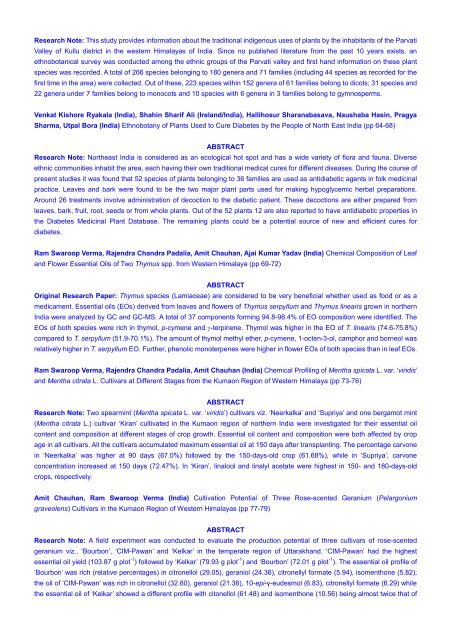Medicinal and Aromatic Plant Science and Biotechnology
Medicinal and Aromatic Plant Science and Biotechnology
Medicinal and Aromatic Plant Science and Biotechnology
You also want an ePaper? Increase the reach of your titles
YUMPU automatically turns print PDFs into web optimized ePapers that Google loves.
Research Note: This study provides information about the traditional indigenous uses of plants by the inhabitants of the Parvati<br />
Valley of Kullu district in the western Himalayas of India. Since no published literature from the past 10 years exists, an<br />
ethnobotanical survey was conducted among the ethnic groups of the Parvati valley <strong>and</strong> first h<strong>and</strong> information on these plant<br />
species was recorded. A total of 266 species belonging to 180 genera <strong>and</strong> 71 families (including 44 species as recorded for the<br />
first time in the area) were collected. Out of these, 223 species within 152 genera of 61 families belong to dicots; 31 species <strong>and</strong><br />
22 genera under 7 families belong to monocots <strong>and</strong> 10 species with 6 genera in 3 families belong to gymnosperms.<br />
Venkat Kishore Ryakala (India), Shahin Sharif Ali (Irel<strong>and</strong>/India), Hallihosur Sharanabasava, Naushaba Hasin, Pragya<br />
Sharma, Utpal Bora (India) Ethnobotany of <strong>Plant</strong>s Used to Cure Diabetes by the People of North East India (pp 64-68)<br />
ABSTRACT<br />
Research Note: Northeast India is considered as an ecological hot spot <strong>and</strong> has a wide variety of flora <strong>and</strong> fauna. Diverse<br />
ethnic communities inhabit the area, each having their own traditional medical cures for different diseases. During the course of<br />
present studies it was found that 52 species of plants belonging to 36 families are used as antidiabetic agents in folk medicinal<br />
practice. Leaves <strong>and</strong> bark were found to be the two major plant parts used for making hypoglycemic herbal preparations.<br />
Around 26 treatments involve administration of decoction to the diabetic patient. These decoctions are either prepared from<br />
leaves, bark, fruit, root, seeds or from whole plants. Out of the 52 plants 12 are also reported to have antidiabetic properties in<br />
the Diabetes <strong>Medicinal</strong> <strong>Plant</strong> Database. The remaining plants could be a potential source of new <strong>and</strong> efficient cures for<br />
diabetes.<br />
Ram Swaroop Verma, Rajendra Ch<strong>and</strong>ra Padalia, Amit Chauhan, Ajai Kumar Yadav (India) Chemical Composition of Leaf<br />
<strong>and</strong> Flower Essential Oils of Two Thymus spp. from Western Himalaya (pp 69-72)<br />
ABSTRACT<br />
Original Research Paper: Thymus species (Lamiaceae) are considered to be very beneficial whether used as food or as a<br />
medicament. Essential oils (EOs) derived from leaves <strong>and</strong> flowers of Thymus serpyllum <strong>and</strong> Thymus linearis grown in northern<br />
India were analyzed by GC <strong>and</strong> GC-MS. A total of 37 components forming 94.8-98.4% of EO composition were identified. The<br />
EOs of both species were rich in thymol, p-cymene <strong>and</strong> γ-terpinene. Thymol was higher in the EO of T. linearis (74.6-75.8%)<br />
compared to T. serpyllum (51.9-70.1%). The amount of thymol methyl ether, p-cymene, 1-octen-3-ol, camphor <strong>and</strong> borneol was<br />
relatively higher in T. serpyllum EO. Further, phenolic monoterpenes were higher in flower EOs of both species than in leaf EOs.<br />
Ram Swaroop Verma, Rajendra Ch<strong>and</strong>ra Padalia, Amit Chauhan (India) Chemical Profiling of Mentha spicata L. var. ‘viridis’<br />
<strong>and</strong> Mentha citrata L. Cultivars at Different Stages from the Kumaon Region of Western Himalaya (pp 73-76)<br />
ABSTRACT<br />
Research Note: Two spearmint (Mentha spicata L. var. ‘viridis’) cultivars viz. ‘Neerkalka’ <strong>and</strong> ‘Supriya’ <strong>and</strong> one bergamot mint<br />
(Mentha citrata L.) cultivar ‘Kiran’ cultivated in the Kumaon region of northern India were investigated for their essential oil<br />
content <strong>and</strong> composition at different stages of crop growth. Essential oil content <strong>and</strong> composition were both affected by crop<br />
age in all cultivars. All the cultivars accumulated maximum essential oil at 150 days after transplanting. The percentage carvone<br />
in ‘Neerkalka’ was higher at 90 days (67.0%) followed by the 150-days-old crop (61.68%), while in ‘Supriya’, carvone<br />
concentration increased at 150 days (72.47%). In ‘Kiran’, linalool <strong>and</strong> linalyl acetate were highest in 150- <strong>and</strong> 180-days-old<br />
crops, respectively.<br />
Amit Chauhan, Ram Swaroop Verma (India) Cultivation Potential of Three Rose-scented Geranium (Pelargonium<br />
graveolens) Cultivars in the Kumaon Region of Western Himalayas (pp 77-79)<br />
ABSTRACT<br />
Research Note: A field experiment was conducted to evaluate the production potential of three cultivars of rose-scented<br />
geranium viz., ‘Bourbon’, ‘CIM-Pawan’ <strong>and</strong> ‘Kelkar’ in the temperate region of Uttarakh<strong>and</strong>. ‘CIM-Pawan’ had the highest<br />
essential oil yield (103.87 g plot -1 ) followed by ‘Kelkar’ (79.93 g plot -1 ) <strong>and</strong> ‘Bourbon’ (72.01 g plot -1 ). The essential oil profile of<br />
‘Bourbon’ was rich (relative percentages) in citronellol (29.05), geraniol (24.36), citronellyl formate (5.94), isomenthone (5.82);<br />
the oil of ‘CIM-Pawan’ was rich in citronellol (32.60), geraniol (21.38), 10-epi-γ-eudesmol (6.83), citronellyl formate (6.29) while<br />
the essential oil of ‘Kelkar’ showed a different profile with citonellol (61.48) <strong>and</strong> isomenthone (10.56) being almost twice that of
















